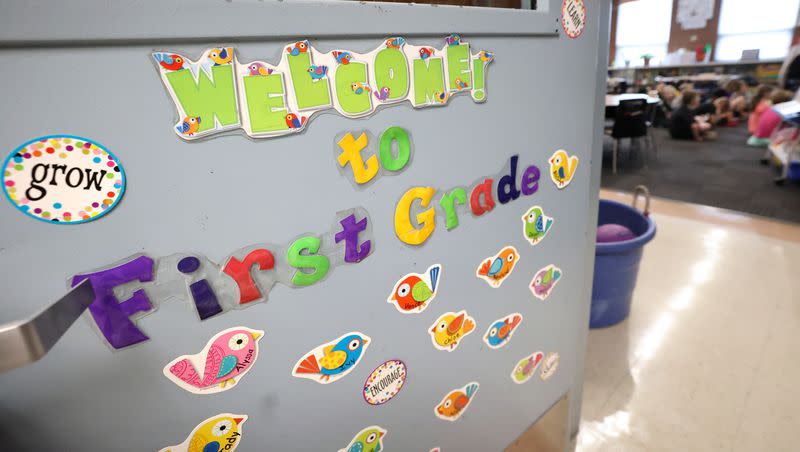Opinion: Utah K-12 performance leads the nation — but elements of this success may be threatened

Utah’s positive public education outcomes have recently been the focus of national attention.
The pre-COVID-19 Stanford Interactive Report on School Effectiveness (2020) showed Utah students having higher than average test scores, learning rates nearly 10% faster than the national average, and test scores improving over time. Overall, Utah students ranked higher than all but two states.
The Education Commission of the States honored Utah with the 2021 Frank Newman Award for State Innovation in recognition of Utah’s commitment to expanding digital learning across the state.
The State Educational Technology Directors Association presented Utah state Superintendent Sydnee Dickson with its 2021 State Policymaker Award, recognizing that when COVID-19 hit, Utah was positioned to quickly and effectively transition to remote learning thanks to many years of preparation, including funding of the nation’s first Statewide Digital Teaching & Learning Masterplan.
In a December 2023 podcast, Eric Hanushek of Stanford’s Hoover Institution compared eighth grade 2022 NAEP math scores. Students in Massachusetts and Utah scored highest. When COVID-19 learning loss was measured, Utah fared best in the nation with almost no loss while the median drop in scores for all states was a disappointing 12 points.
Why is Utah public education ahead of the curve?
Related
One reason is that the Beehive State’s K-12 organizational structure is functionally among the best in the nation. The elected Utah State Board of Education, or USBE, hires the state superintendent who, together with her highly qualified staff, works closely with the Legislature throughout the year in examining, adopting and funding research-based solutions. The USBE staff then works closely with school districts, charter schools and four regional service centers to ensure Utah teachers have the training and tools to improve instructional practices and student outcomes. Utah policymakers have learned that if 30,000 classroom teachers don’t have buy-in, even the best policies are ignored and the best digital tools go unused. That’s why training has been integral to implementing instructional improvements.
This collaborative approach has yielded significant teaching and learning improvements.
In 2008, the Legislature and USBE implemented Waterford Upstart, a statewide program which now offers every 4-year-old in Utah access to 15 minutes per day of kindergarten readiness using interactive and adaptive education technology. Third-party analyses have shown Upstart to be especially effective in assisting even disadvantaged children to start kindergarten at advanced levels. Its effects are so remarkable that Upstart has been identified by TED Global as one of Eight Audacious Ideas that Can Change the World.
Since 2012, Utah K-3 teachers have had access to high quality adaptive computer-based reading software to give students 20 minutes of personalized reading instruction per day. Teachers use the reports from the software to target one-on-one and small group instruction to bring struggling readers to grade level.
Utah’s STEM Action Center was created by legislation in 2013. A key part of its mission is to promote K-12 Math Personalized Learning Software Grants, which provide teachers with access to a selection of high-quality, cost-effective personalized learning software programs to improve student outcomes in mathematics literacy.
As noted above, Utah has been recognized for establishing the first Statewide Digital Teaching and Learning Master Plan. Schools representing more than 95% of K-12 students have received the grants and educator training on the effective use of digital teaching and learning tools.
In 2020, USBE teaching and learning staff convinced the state board to engage a statewide contract for Scrible, a cutting-edge tool which enables teachers to improve critical thinking as students engage in research and writing assignments. In late 2022, the USBE’s decision proved to be visionary as ChatGPT enabled undetectable plagiarism. The Scrible platform ensures teachers can see and mentor students’ research, curation and synthesis of ideas in real time from start to finish.
The USBE worked with the Legislature in the 2022 session to enact Science of Reading legislation, ensuring Utah classroom teachers are trained in delivering phonics-based reading instruction. The goal is to raise reading proficiency for young students to 70% by 2027.
Unfortunately, the Digital Teaching and Learning program has been included on a list of programs at risk of being discontinued and its $19.9 million annual funding rolled into the Weighted Pupil Unit. The Legislature is engaged in a three-year process to review which programs may have outlived their usefulness or which should be funded locally.
Those advocating defunding mistakenly assume that since COVID-19 forced public education to step up to online learning, proficiency in digital learning has already been achieved. This notion misses the fact that the frontier of digital learning is only in its infancy. Every week brings new digital tools, which are assessed and evaluated by USBE staff experts, saving local schools from expending scarce resources to review the onslaught of new tools, some of which are extremely effective while others are snake oil.
I am hopeful that the constructive working relationship between Utah’s education community and the Legislature will continue to advance evidence-based best practices in an ever-changing world.
Howard Stephenson is a former Utah state senator who chaired education committees during his 26-year legislative tenure.

